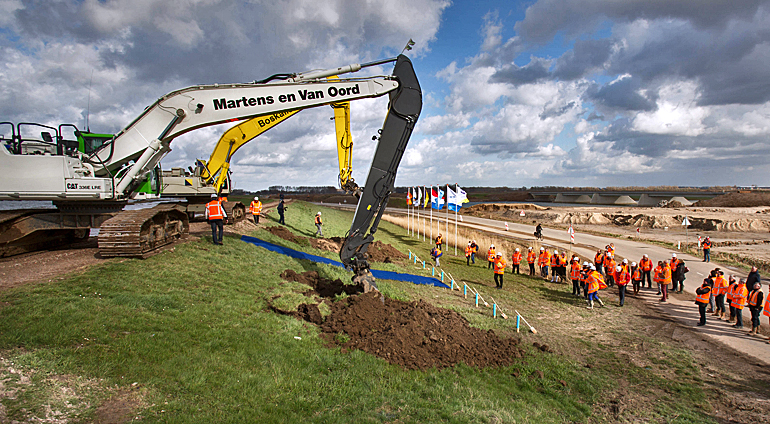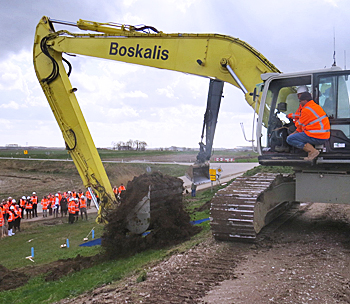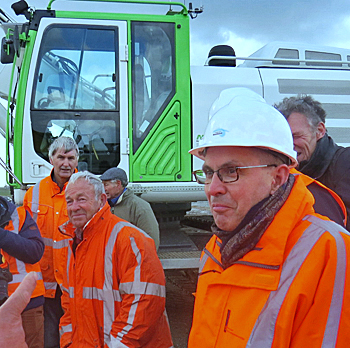Rijkswaterstaat takes down Noordwaard levee to give river Rhine more room
 Instead of raising the river levee, the Dutch national public works Rijkswaterstaat started to lower the levee along the river Rhine with 3 meters over a length of 2 km. In case of an extreme river discharge, the river will overtop the lowered levee and flood the hinterland, the Noordwaard polder.
Instead of raising the river levee, the Dutch national public works Rijkswaterstaat started to lower the levee along the river Rhine with 3 meters over a length of 2 km. In case of an extreme river discharge, the river will overtop the lowered levee and flood the hinterland, the Noordwaard polder.
During the past four years Rijkswaterstaat has restructured this 2,000 ha polder so it can flood without posing a risk to the remaining 50 homes, and farmers can maintain their farm lands.
On 1 April CEO Jan Hendrik Dronkers of Rijkswaterstaat and René Cruijsen of regional water authority Rivierenland launched the actual depoldering of Noordwaard. They controlled two excavators and took the first chunks of earth out of the river levee, near Werkendam.
Excavation of the primary flood defense of the Noordwaard polder, is the final stage of one of the biggest projects of the national Room for the River programme.
 A most remarkable event in the Netherlands: taking down of the Rhine levee.
A most remarkable event in the Netherlands: taking down of the Rhine levee.
Very remarkable moment: dig into levee
For Dutch circumstances it is very remarkable to have two excavators to dig into a levee.
For centuries levees have prevented the Netherlands from flooding and because of climate change - with its expected sea level rise and bigger river charges - it would seem more logical to raise the levees rather than lower them.
However, at certain locations the Dutch water authorities decided to create more room for the river Rhine. At some locations retention areas are being constructed where - by lowering the levees - the water can freely flow into these areas at a certain water level. One of these locations is the Noordwaard polder.
The new height of the levee that protects this depoldered area from river floods, is carefully selected.
In case of an extreme large river discharge that may occur once in 2000 years, enough water can flow into the polder to lower the water level near the city of Gorinchem by 30 centimeters.
On the other hand the levee will remain high enough to prevent the area from flooding too often. This would damage the grassland agriculture. It is expected for the levee to overflow once a year.
 According to CEO Jan Hendrik Dronkers (right) of Rijkswaterstaat, lowering the levee is a consequence of the envitable change in Dutch flood protection policies.
According to CEO Jan Hendrik Dronkers (right) of Rijkswaterstaat, lowering the levee is a consequence of the envitable change in Dutch flood protection policies.
Next step in flood protection
CEO Jan Hendrik Dronkers of Rijkswaterstaat explained that the depoldering of Noordwaard is a logical next step in de development of flood risk management in the Netherlands. "We always have to improve it. Doing so, we have realized that we cannot raise our defences endlessly. We learned that it is better to live with the water and use nature to reduce our flood risks. This is what we are now putting to practise along the Rhine in a string of 30 projects."
Dronkers admired the flexibility of the inhabitants of the polder. Many houses have been demolished and rebuild on high level mounts. "Four years ago, more than 30 of the 75 families decided to continue living in the polder, knowing the restructuring of the polder would bring them a difficult period. They have literally lived in an enormous pit. It is admirable how flexible the residents have been. They deserve a great compliment."
The Noordwaard depoldering project is scheduled to be ready by October this year.
About Room for the river
Room for the river is a national flood prevention programme, comprising 30 projects mainly along the river Rhine, Netherland's largest river.
The programme has two objectives. By giving the Rhine river more room its discharge capacity will rise from 15.000 m3/s to 16.000 m3/s. Additionally the projects will improve the spatial quality as well, making the river also economic and environmental more vital.
The Room for the River programme will cost 2,3 billion euro and most projects will be completed by 2015.
Also read on this website
● Groundbreaking ceremony for Europe's largest floodplain city park in Arnhem, the Netherlands, 17 January 2014
● Go-ahead for Rijkswaterstaat's largest flood water storage in lake Volkerak, the Netherlands, 29 September 2013
● Boskalis contracted for Dutch Room for the River project at Veessen-Wapenveld, the Netherlands, 4 July 2013
● Groundbreaking ceremony biggest Room for the River project: a 3 km long side-channel, 24 January 2013
● International River Symposium debated flood risk reductions by giving rivers more room, 10 October 2012
● Room for the river: First dairy farmer moves to new farm on 6 m high mound in Overdiepse polder, 11 August 2012
● New 'tap' splits Rhine highwater with great accuracy over two rivers, 31 January 2012
● Room for the river project
More information
Room for the river programme directorate
Rijkswaterstaat
Utrecht, the Netherlands
+31 88 797 2900
www.ruimtevoorderivier.nl/english



